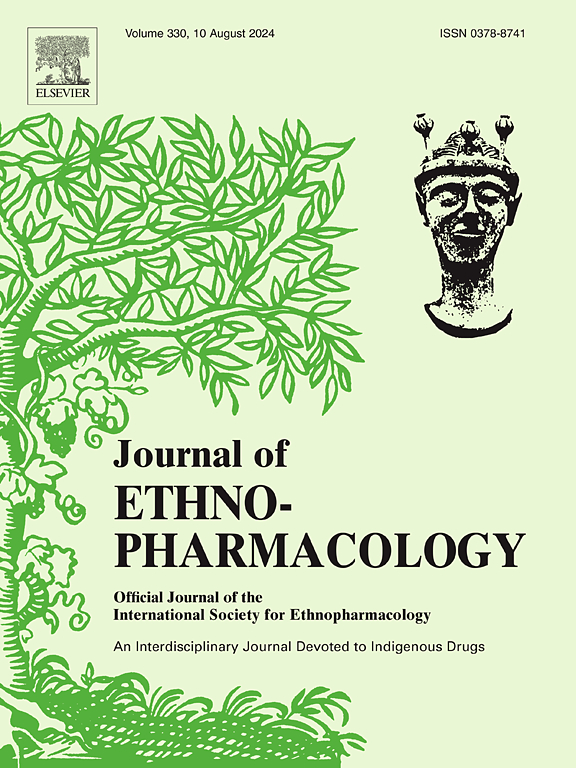Ermiao San attenuating rheumatoid arthritis via PI3K/AKT/mTOR signaling activate HIF-1α induced glycolysis
IF 4.8
2区 医学
Q1 CHEMISTRY, MEDICINAL
引用次数: 0
Abstract
Ethnopharmacological relevance
As a classic formula, Ermiao San (EMS) characterized by its less medicinal flavor and strong potency had been proven to be effective and safe in the treatment of rheumatoid arthritis (RA) during clinical experience and our previous research.
Aim of the study
The therapeutic characteristics of multi-component and multi-target of traditional Chinese medicine prompted us to further investigated the effective compounds of EMS, and evaluated its potential mechanisms in treating RA.
Materials and methods
Ultra-high-performance liquid chromatography high-resolution mass spectrometry (UPLC-HRMS) was used to analyze the primary absorption components of EMS in rat serum, with secondary mass spectrometry used to assist in identifying the structures of the compounds. Open field experiments, H&E staining, safranin-O-turquoise staining, ELISA, and other methods were applied to verify the alleviating effects of EMS on exercise capacity, inflammation, and cartilage damage in CIA rats. The RA-FLS model was established using TNF-α, and observed the effects of EMS on cell migration and invasion were observed through wound healing and transwell assays. In addition, immunohistochemistry and western blotting were employed to investigate the PI3K/AKT/mTOR/HIF-1α pathway both in vivo and in vitro.
Results
Seventeen compounds were identified in rat serum, which were considered as active ingredients involved in the improvement of RA by EMS. Furthermore, EMS demonstrated the outstanding anti-RA ability, as evidenced by the improvement in foot swelling and arthritis scores, alleviation of pathological changes in joint tissue, inhibition of inflammatory factors, and restoration of exercise ability. In vivo data showed that EMS reduced joint injury through the PI3K/AKT/mTOR/HIF-1α signaling pathway. In vitro studies indicated that TNF-α induced the expression of Glut1 and HK2 proteins, accelerated the glycolysis rate, and promoted migration and invasion of RA-FLS cells, leading to adverse outcomes. However, EMS regulated the expression of glycolysis-related molecules, HK2 and Glut1 through the PI3K/AKT/mTOR/HIF-1α pathway, thereby inhibiting inflammation, migration, and invasion of RA-FLS cells.
Conclusion
The beneficial effects of EMS in CIA rats can be attributed to the inhibition of glycolysis in synovial fibroblasts via the PI3K/AKT/mTOR/HIF-1α pathway. This finding further enriches our understanding of the mechanisms by which EMS contributes to the treatment of RA.

求助全文
约1分钟内获得全文
求助全文
来源期刊

Journal of ethnopharmacology
医学-全科医学与补充医学
CiteScore
10.30
自引率
5.60%
发文量
967
审稿时长
77 days
期刊介绍:
The Journal of Ethnopharmacology is dedicated to the exchange of information and understandings about people''s use of plants, fungi, animals, microorganisms and minerals and their biological and pharmacological effects based on the principles established through international conventions. Early people confronted with illness and disease, discovered a wealth of useful therapeutic agents in the plant and animal kingdoms. The empirical knowledge of these medicinal substances and their toxic potential was passed on by oral tradition and sometimes recorded in herbals and other texts on materia medica. Many valuable drugs of today (e.g., atropine, ephedrine, tubocurarine, digoxin, reserpine) came into use through the study of indigenous remedies. Chemists continue to use plant-derived drugs (e.g., morphine, taxol, physostigmine, quinidine, emetine) as prototypes in their attempts to develop more effective and less toxic medicinals.
 求助内容:
求助内容: 应助结果提醒方式:
应助结果提醒方式:


